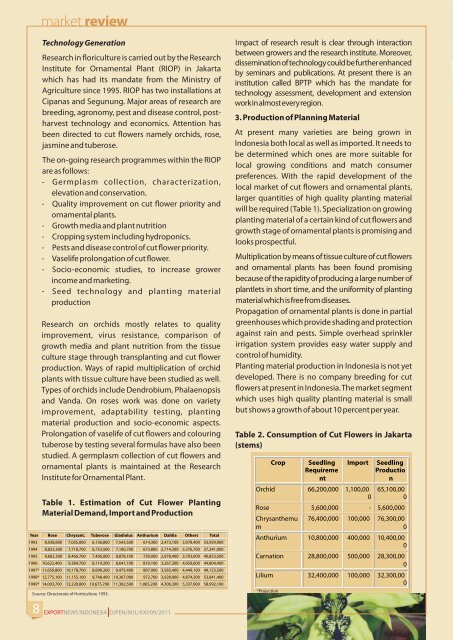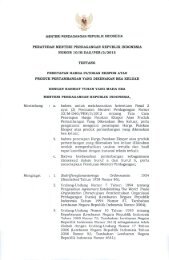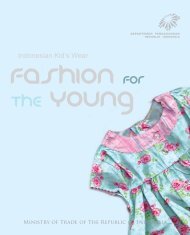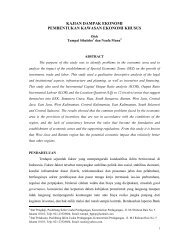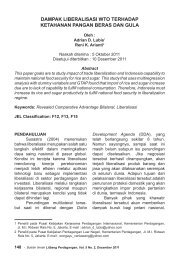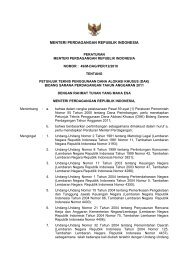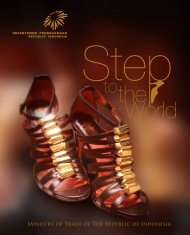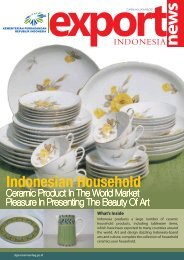Ornamental Plants - Directorate General for National Export ...
Ornamental Plants - Directorate General for National Export ...
Ornamental Plants - Directorate General for National Export ...
You also want an ePaper? Increase the reach of your titles
YUMPU automatically turns print PDFs into web optimized ePapers that Google loves.
market review<br />
8<br />
Technology Generation<br />
Research in floriculture is carried out by the Research<br />
Institute <strong>for</strong> <strong>Ornamental</strong> Plant (RIOP) in Jakarta<br />
which has had its mandate from the Ministry of<br />
Agriculture since 1995. RIOP has two installations at<br />
Cipanas and Segunung. Major areas of research are<br />
breeding, agronomy, pest and disease control, postharvest<br />
technology and economics. Attention has<br />
been directed to cut flowers namely orchids, rose,<br />
jasmine and tuberose.<br />
The on-going research programmes within the RIOP<br />
are as follows:<br />
- Germplasm collection, characterization,<br />
elevation and conservation.<br />
- Quality improvement on cut flower priority and<br />
ornamental plants.<br />
- Growth media and plant nutrition<br />
- Cropping system including hydroponics.<br />
- Pests and disease control of cut flower priority.<br />
- Vaselife prolongation of cut flower.<br />
- Socio-economic studies, to increase grower<br />
income and marketing.<br />
- Seed technology and planting material<br />
production<br />
Research on orchids mostly relates to quality<br />
improvement, virus resistance, comparison of<br />
growth media and plant nutrition from the tissue<br />
culture stage through transplanting and cut flower<br />
production. Ways of rapid multiplication of orchid<br />
plants with tissue culture have been studied as well.<br />
Types of orchids include Dendrobium, Phalaenopsis<br />
and Vanda. On roses work was done on variety<br />
improvement, adaptability testing, planting<br />
material production and socio-economic aspects.<br />
Prolongation of vaselife of cut flowers and colouring<br />
tuberose by testing several <strong>for</strong>mulas have also been<br />
studied. A germplasm collection of cut flowers and<br />
ornamental plants is maintained at the Research<br />
Institute <strong>for</strong> <strong>Ornamental</strong> Plant.<br />
Table 1. Estimation of Cut Flower Planting<br />
Material Demand, Import and Production<br />
Year Rose Chrysant. Tuberose Gladiolus Anthurium Dahlia Others Total<br />
1993 8,038,800 7,035,000 6,156,800 7,543,500 614,300 2,473,100 3,078,400 33,939,900<br />
1994 8,823,300 7,718,700 6,753,500 7,180,700 673,800 2,714,300 3,376,700 37,241,000<br />
1995 9,682,300 8,466,700 7,406,000 8,878,100 739,000 2,978,400 3,703,000 40,853,500<br />
1996 10,622,400 9,384,700 8,119,200 8,641,100 810,100 3,267,300 4,059,600 44,804,400<br />
1997* 11,650,800 10,178,700 8,898,200 9,475,400 887,900 3,583,400 4,449,100 49,123,500<br />
1998* 12,775,100 11,155,100 9,748,400 10,387,000 972,700 3,928,900 4,874,200 53,841,400<br />
1999* 14,003,700<br />
12,220,800 10,675,700<br />
Source: <strong>Directorate</strong> of Horticulture 1993.<br />
11,382,500 1,065,200 4,306,300 5,337,900 58,992,100<br />
EXPORTNEWS INDONESIA DJPEN/MJL/XXI/09/2011<br />
Impact of research result is clear through interaction<br />
between growers and the research institute. Moreover,<br />
dissemination of technology could be further enhanced<br />
by seminars and publications. At present there is an<br />
institution called BPTP which has the mandate <strong>for</strong><br />
technology assessment, development and extension<br />
work in almost every region.<br />
3. Production of Planning Material<br />
At present many varieties are being grown in<br />
Indonesia both local as well as imported. It needs to<br />
be determined which ones are more suitable <strong>for</strong><br />
local growing conditions and match consumer<br />
preferences. With the rapid development of the<br />
local market of cut flowers and ornamental plants,<br />
larger quantities of high quality planting material<br />
will be required (Table 1). Specialization on growing<br />
planting material of a certain kind of cut flowers and<br />
growth stage of ornamental plants is promising and<br />
looks prospectful.<br />
Multiplication by means of tissue culture of cut flowers<br />
and ornamental plants has been found promising<br />
because of the rapidity of producing a large number of<br />
plantlets in short time, and the uni<strong>for</strong>mity of planting<br />
material which is free from diseases.<br />
Propagation of ornamental plants is done in partial<br />
greenhouses which provide shading and protection<br />
against rain and pests. Simple overhead sprinkler<br />
irrigation system provides easy water supply and<br />
control of humidity.<br />
Planting material production in Indonesia is not yet<br />
developed. There is no company breeding <strong>for</strong> cut<br />
flowers at present in Indonesia. The market segment<br />
which uses high quality planting material is small<br />
but shows a growth of about 10 percent per year.<br />
Table 2. Consumption of Cut Flowers in Jakarta<br />
(stems)<br />
Crop<br />
Seedling<br />
Requireme<br />
nt<br />
Import<br />
Seedling<br />
Productio<br />
n<br />
Orchid 66,200,000 1,100,00<br />
0 65,100,00 0<br />
Rose 5,600,000 - 5,600,000<br />
Chrysanthemu<br />
m<br />
76,400,000 100,000 76,300,00<br />
0<br />
Anthurium 10,800,000 400,000 10,400,00 0<br />
Carnation 28,800,000 500,000 28,300,00<br />
0<br />
Lilium 32,400,000 100,000 32,300,00<br />
0<br />
*Projection


